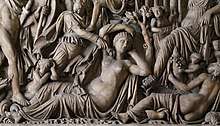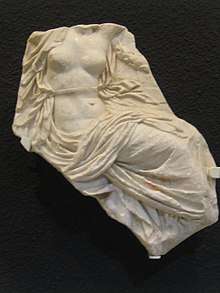Rhea Silvia
Rhea Silvia /ˈriːə ˈsɪlviə/ (also written as Rea Silvia), and also known as Ilia /ˈɪliə/,[1] was the mythical mother of the twins Romulus and Remus, who founded the city of Rome.[2] Her story is told in the first book of Ab Urbe Condita Libri of Livy[3] and in Cassius Dio's Roman History.[4] The Legend of Rhea Silvia recounts how she was raped by Mars while she was a Vestal Virgin and as a result became the Mother of Romulus and Remus the founders of Rome.[5] This event would be portrayed numerous times in Roman art[6] while in the story was mentioned both in the Aeneid,[7] and in the works of Ovid. Modern academics considers both how Rhea Silvia is a relevant for the treatment of rape victims in Roman mythology as well as the different ways she is portrayed in Roman art.[6]

Legend

According to Livy's account of the legend she was the daughter of Numitor, king of Alba Longa, and descended from Aeneas. Numitor's younger brother Amulius seized the throne and killed Numitor's son, then forced Rhea Silvia to become a Vestal Virgin, a priestess of the goddess Vesta. As Vestal Virgins were sworn to celibacy, this would ensure the line of Numitor had no heirs. Rhea, however, became pregnant with the twins Romulus and Remus, ostensibly by the god Mars.[8]
According to Plutarch, she believed this because she saw her children being cared for by a wood pecker and a wolf – animals sacred to Mars.[9] The account says that Rhea Silvia went to a grove sacred to Mars to get water for use in the temple[10] where she encountered Mars who attempted to rape her, she ran into a cave to escape him but to no avail. Mars then promised that her children would be great.[11] These claims of her children's paternity were later doubted by the Roman historian Livy.[12]
Vesta, to show her displeasure at the birth of Rhea Silvia's children, caused the holy fire in her temple to go out, shook her altar, and shut the eyes of her image.[13] According to Ennius, the goddess Venus was more sympathetic to Rhea Silvia's plight.[14]

When Amulius learned of the birth he imprisoned Rhea Silvia and ordered a servant to kill the twins. But the servant showed mercy and set them adrift on the river Tiber, which, overflowing, left the infants in a pool by the bank. There, a she-wolf (lupa), who had just lost her own cubs, suckled them.[15] Rhea Silvia was herself spared from death due to the intercession of Amulius' daughter.[16] According to Ovid, Rhea Silvia ultimately threw herself into the Tiber.[17]
Romulus and Remus overthrew Amulius and reinstated Numitor as king in 752 BCE. They would then go to found Rome.[18][19]
In Roman art

Despite Livy's euhemerist and realist deflation of this myth, it is clear that the story of her seduction by Mars continued to be widely accepted. This is demonstrated by the recurring theme of Mars discovering Rhea Silvia in Roman arts: In bas-relief on the Casali Altar (Vatican Museums), in engraved couched glass on the Portland Vase (British Museum), or on a sarcophagus in the Palazzo Mattei. Mars' discovery of Rhea Silvia is a prototype of the "invention scene" ("discovery scene") familiar in Roman art; Greek examples are furnished by Dionysus and Ariadne or Selene and Endymion.
The Portland Vase features a scene that has been interpreted as a depiction of the "invention", or coming-upon, of Rhea Sylvia by Mars.[20]
In the Museuo Nazionale Romano there is a depiction of Rhea Silvia sleeping during the conception of Romulus and Remus in a Relief.[21]
In Roman literature
In a version presented by Ovid, it is the river Anio who takes pity on her and invites her to rule his realm.[22]
In the Aeneid, Anchises gives a prophecy that Rhea Silvia would give birth to Romulus and Remus by Mars.[23]
Rhea Silvia's bearing of Romulus in mentioned in the Roman work, Vigil of Venus.[24]
Academic analyses
- In an article by Rosanna Lauriola, Rhea Silvia is held up as an example of how rape victims in Roman myths are valued more as the mothers and catalysts for change than as individuals in their own right.[25]
- A paper by Revika Gersht and Sonia Muryink divides the images of Rhea Silvia’s conception by Mars into as many as seven different types.[26]
Modern literature
- In David Drake's science fiction story "To Bring the Light", the time travelling protagonist meets a completely human Rhea Silvia, a sympathetic peasant living in a small shepherd community on Palatine Hill in what would become the city of Rome.[27]
- In Rick Riordan's novel " The Mark of Athena" , Annabeth Chase Meets Rhea Silvia and the god of the river Tiber in the forms of Audrey Hepburn and Gregory Peck's characters from the movie "Roman Holiday"
See also
| Wikimedia Commons has media related to Rhea Silvia. |
Footnotes
- Dio, Cassius (1914). Dio's Roman History. Translated by Earnest, Cary; Foster, Herbert Baldwin. Cambridge, MA: Harvard University Press. p. 13.
- Livy (1960). The History of Early Rome. Translated by de Selincourt, Aubrey; Scorzelli, Raffaele. New York: Heritage Press. pp. 9–11.
- Livy (1960). The History of Early Rome. Translated by de Selincourt, Aubrey; Scorzelli, Raffaele. New York: Heritage Press. pp. 9–11.
- Dio, Cassius (1914). Dio's Roman History. Translated by Cary, Earnest; Foster, Herbert. Cambridge, MA: Harvard University Press. p. 13.
- Livy I.4.2
- Gersht, Rivka; Mucznik, Sonia. "Mars and Rhea Silvia" (PDF). pp. 116–123.
- Mathisen, Ralph W. (2019). Ancient Roman Civilization: History and sources. New York: Oxford University Press. p. 246.
- Livy I.4.2
- Mathisen, Ralph W. (2019). Ancient Roman Civilization: History and sources. New York: Oxford University Press. p. 69.
- Dio. Dio's Roman History. Translated by Earnest, Cary; Foster, Herbert Baldwin. Cambridge Massachusetts.
- Niebuher, B.G. (3 April 1843). "The History of Rome". p. 184.
- Livy (1960). The History of Early Rome. Translated by de Selincourt, Aubrey; Scorzelli, Raffaele. New York: Heritage Press. p. 9.
- Niebuhr, B.G. (3 April 1843). "The History of Rome". pp. 184–185.
- Arieti, J.A. (1997). Rape in Antiquity: Rape and Livy's View of Roman History. p. 11. ISBN 9781905125876.
- The she-wolf is memorialised in the Medieval bronze Capitoline Wolf and is a symbol of Rome.
- Dio, Cassius. Dio's Roman History. Translated by Earnest, Cary; Foster, Herbert Baldwin. Cambridge, MA. p. 13.
- Arieti, J.A. (1997). Rape in Antiquity: Rape and Livy's view of Roman History. p. 210. ISBN 9781905125876. Retrieved 21 February 2020.
- Dionysius of Halicarnassus, Roman Antiquities, 71.5
- Livy, Ab Urbe Condita, Book 1.
- Noted by Haynes, D.E.L. (1968). "The Portland Vase again". The Journal of Hellenic Studies. 88: 67.
- Albertson, Fred C. (1987). "An Augustan temple represented on a historical relief dating to the time of Claudius". American Journal of Archaeology. 91 (3): 441–458. doi:10.2307/505365. JSTOR 505365.
- Ovid. "The Flooded River". Amores. Book III, Elegy VI.
- Mathisen, Ralph W. (2019). Ancient Roman Civilization: History and sources. New York: Oxford University Press. p. 246.
- Mathisen, Ralph W. (2019). Ancient Roman Civilization: History and sources. New York: Oxford University Press. p. 363.
- Lauriola, Rosanna (2013). "Teaching About the Rape of Lucretia: A Student Project". p. 682. Retrieved 21 February 2020.
- Gersht, Rivka; Mucznik, Sonia. "Mars and Rhea Silvia" (PDF). pp. 116–123.
- Drake, David (2011). "To Bring the Light". Lest Darkness Fall and Related Stories (collection).
External links
- Livy. . Ab urbe condita.
- Ennius, Quintus. "The Dream of Ilia (Rhea Silvia)". Annales. Book 1.
